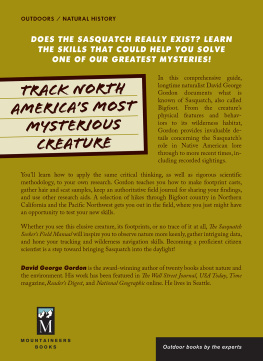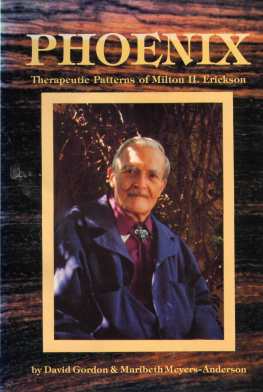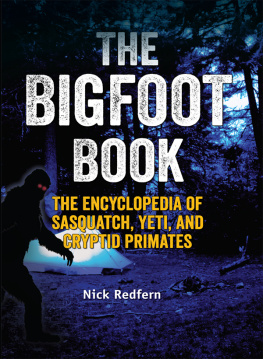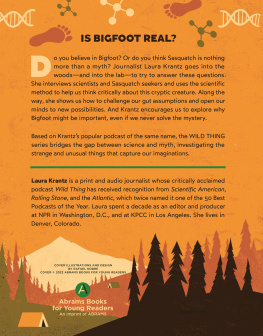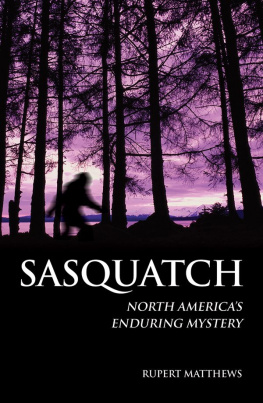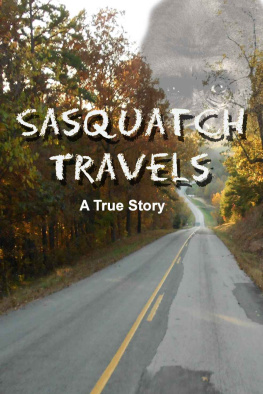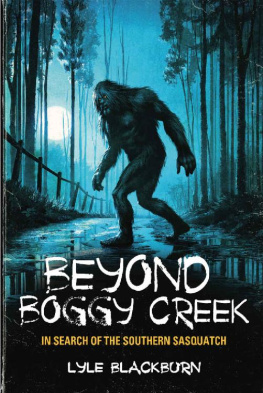THE
SASQUATCH SEEKERS
FIELD MANUAL

THE
SASQUATCH SEEKERS
FIELD MANUAL
USING CITIZEN SCIENCE TO UNCOVER NORTH AMERICAS MOST ELUSIVE CREATURE
DAVID GEORGE GORDON
ILLUSTRATIONS BY
RICHARD L. GOETTLING


Mountaineers Books is the publishing division of The Mountaineers, an organization founded in 1906 and dedicated to the exploration, preservation, and enjoyment of outdoor and wilderness areas.
1001 SW Klickitat Way, Suite 201, Seattle, WA 98134 800.553.4453, www.mountaineersbooks.org
Copyright 2015 by David George Gordon
All rights reserved. No part of this book may be reproduced or utilized in any form, or by any electronic, mechanical, or other means, without the prior written permission of the publisher.
Printed in the United States of America
First edition, 2015
Copyeditor: Anne Moreau
Designer: Jen Grable
Illustrator: Richard L. Goettling
Cartographer: Matt Dressler
Selected hikes in this book were inspired by books in the Day Hiking guidebook series (published by Mountaineers Books), by authors Craig Romano, Dan Nelson, and Tami Asars, as well as by US Forest Service and BC Parks information.
Cover illustration by Richard L. Goettling
Frontispiece: An artists conception of Sasquatch, based on eyewitness reports and footprint casts
Library of Congress Cataloging-in-Publication Data
Gordon, David G. (David George), 1950
The Sasquatch seekers field manual : using citizen science to uncover North Americas most elusive creature / David George Gordon; illustrations by Richard L. Goettling.First edition.
pages cm
Includes bibliographical references and index.
ISBN 978-1-59485-941-0 (pbk.)ISBN 978-1-59485-942-7 (ebook)
1. SasquatchNorth America. 2. HikingEquipment and supplies. I. Title.
QL89.2.S2G674 2015
001.944dc23
2014047190
ISBN (paperback): 978-1-59485-941-0
ISBN (ebook): 978-1-59485-942-7
To Karen, a staunch supporter of the Wild Man of the Woods, who understands why we need the Sasquatch more than the Sasquatch needs us, and whom I love with all my heart and soul
An extraordinary claim requires extraordinary proof.
Marcello Truzzi
CONTENTS
ACKNOWLEDGMENTS
I wish to thank the many Sasquatch scholars who have generously shared their views, published and unpublished, with me. They include John Bindernagel, Peter Byrne, Loren Coleman, Ren Dahinden, John Green, Richard Greenwell, Grover Krantz, Jeff Meldrum, Matt Moneymaker, Robert W. Morgan, Kathy Moskowitz Strain, John Napier, Brian Regal, and Wayne Suttles. I also wish to thank my agent, Anne Depue, as well as copyeditor Anne Moreau, editor Laura Shauger, cartographer Matt Dressler, and illustrator Richard Goettling. Three cheers for Jen Grable, production coordinator; Kate Rogers, editor in chief; and Helen Cherullo, publisher, all of Mountaineers Books. I am extremely grateful to my family, friends, and fellow members of the Northwest Science Writers Association for their enthusiastic support of this endeavor.
INTRODUCTION
Im often asked whether the Sasquatch really exists. In 1992, around the time of the publication of Field Guide to the Sasquatch, my initial book on this subject, Id answer that I was a fence sitter. I would explain that if I said there was no such thing and, shortly thereafter, someone found and photographed the Sasquatchwell, Id be wrong, wouldnt I? But, Id also tell people that I wouldnt go to court with the evidence we had collected so far. Basically, Id tell my interlocutors, I could go either way.
More than two decades have passed since that earlier work was released, and my answer to the question has expanded. Now, when people ask if I think theres something out theresomething big and hairy and wild and mysteriousI answer, I really dont know. You tell me.
So my stance hasnt changed all that muchIm still divided on the status, real or imagined, of what could very well be the most sensational being on the North American continent. However, my stance on the implications of the question, and how it will be answered, has changed. Now I feel that the responsibility for solving this long-standing mystery rests on the shoulders of all of us: you, the readers of this book, and all who work together to discover the truth.
If this riddle is ever answered, it wont, in all probability, happen because some fortunate soul manages to follow this creatures footsteps back to its forested lair. Believe me, many skilled individuals and, in several instances, entire teams of experts, have tried to do just that and have returned with precious little to show for it. Perhaps thats because theres too much unexplored terrain in the Pacific Northwest for one person or group of people to cover. Or maybe the Sasquatch is too evasive for even these experienced individuals to find on their own.
But what if we could combine the efforts of several thousand people trained in reconnaissance, skilled in the techniques of field biology, and equipped with the necessary gear to work on this case? What if we harnessed the power of large groups of people working together to solve problems? I maintain it will take no less than thatthousands of pairs of eyes and ears, collectively gathering and sharing information that can further our understanding and, ultimately, lead us to this mysterious mammal, if indeed thats what it is.
Thats where youand this field manualcome in.
This book is divided into three major sections. The first part lays out the basics about the Sasquatch, offering an overview of what we know so far, the creatures probable basic biology, life history, and place in cultures and belief systems from around the world. Along the way, it also introduces the tenets of citizen science, the rules governing the naming of animals and plants, and the relatively new science of cryptozoology.
The second part of this book contains information on mounting a Sasquatch search. It also explains the standard operating procedures, or protocols, for amassing evidence from fieldwork and sharing it with scientists and other Sasquatch seekers.
The final part includes a selection of suitable locations for day hikes that take you into some of the prime Sasquatch-searching territory in British Columbia, Washington (two areas), Oregon, and California. These five sites were selected because of their significance in Sasquatch lore; they may well be the best places for finding important evidence or even seeing the creature firsthand in the wild. They are areas where people have had close encounters in the past or where a record of Sasquatch sightings exists. I must admit that I also chose these spots for their entertainment value: theres a good yarn connected with each of the siteswhich you can use to inspire your hiking companions as they ready themselves for a long and, hopefully, productive day of Sasquatch seeking.


